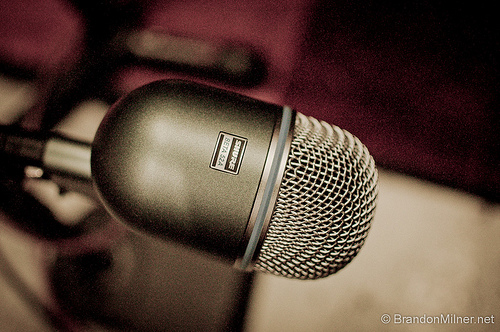Floor toms can be tricky to mic because of their frequency range. Mics designed for snares sometimes miss the rich lower frequencies, making the sound thin and hollow; mics meant for kick drums can have the opposite problem. If you’re in the market for a good floor tom mic, the choices below are all viable options. With a choice for every price point, you’re guaranteed to find something that gives you the sound you need within your budget range.
These are our recommendations for the 4 best floor tom mics on the market:
Sennheiser E604 Dynamic Cardioid Tom Mic
There are two particular qualities that make this mic perfect for floor toms: the low rate of distortion and the resistance to noise from handling or impacts. The built-in mounting system is also convenient, letting you clip it right to the rim of your tom, and you can adjust both the height and the angle of the microphone to get exactly the sound you’re looking for.
Sennheiser is able to make the body more compact and lighter weight by using a reinforced glass fiber instead of metal. This material is just as rugged, protecting the mic from damage without bogging it down for a small but powerful dynamic mic that you can count on.
MXL A-55 Kicker Tom Mic
A lot of players use the floor tom for its low-end frequencies. A mic that’s designed to sound good in that range like the A-55 Kicker from MXL will give you the rich, deep bass tones you’re seeking. The frequency response goes as low as 30Hz, perfect for capturing that low rumble. It uses a standard cardioid pickup pattern that effectively isolates the floor tom’s sound from the rest of the drums in your kit.
In terms of exterior design, the metal casing is solid and rugged, effective at preventing the majority of damage from drops or hits. Its compact size and shape also make it easier to position in the often cramped real estate around your floor tom. This is surely one of the best floor tom mics for the money.
CAD D10 Tom Mic
If your budget is very tight, the D10 from CAD is your best option. It excels at capturing the low frequency tones of both kick drums and floor toms. It gives you a deep tone with a sharp, crisp attack, and doesn’t neglect the mid-range tones of the floor tom, either.
The attached mount lets you adjust the tilt of the microphone, though you won’t get as wide a range of adjustment as with some pricier models. If you’re looking for accurate and easy micing of your floor tom on a budget, the CAD D10 is a great choice.
Shure PGA56-XLR Swivel-mount Dynamic Tom Mic
An option that’s great for capturing the distinctive sound of a floor tom is this swivel-mounted dynamic mic from Shure. It’s designed for use with mounted toms but will capture the sound of a floor tom equally well, especially if you use a more compact kit.
The main complaint users have about the PGA56 isn’t about the microphone itself but instead the mounting system, which uses a claw-shaped design that doesn’t always hold securely to drum rims while you’re playing. This tends to be a drum-to-drum matter, however, and if the mounting isn’t a problem with your set-up, this Shure will give you a full, realistic sound for generally a lower price than the Sennheiser above (though prices do fluctuate).
What to Look for in the Best Floor Tom Mics
Dynamic microphones tend to work best for percussion. They have the sensitivity to accurately capture complex harmonics and sonic textures across a wide frequency range, from the lowest bass drum to the shimmer of your cymbals. They’re also able to stand up to louder dynamics and sharp attacks without wearing out, meaning they’ll be more durable than condenser or ribbon microphones used in the same applications.
When you’re micing individual drums, you want to look for a cardioid polar pattern. This will capture all of the sound in front of the mic without getting too much bleed from the other instruments around it—a necessary feature when it comes to a drum kit, where there are so many different textures clustered together.
For a floor tom, the low end of the frequency range is going to be more important than the high end. You can use mics designed for either mounted toms or kick drums. Both will typically give you the frequency response you need to get a rich and balanced tone, though they may emphasize different aspects of the instrument’s range.
How to Choose
The main difference you’ll find between mics at different price points is the quality of the microphone components. A pricier option like the Sennheiser (see full specs) will pick up more of the nuance of your drum’s sound, giving you a more realistic capture. You may not need quite that level of sensitivity, however, especially if you’re working this floor tom mic into a larger drum kit micing set-up.
There are also slight differences in the mounting apparatus between models. One is not necessarily better than the others categorically, but you may find one microphone better-suited to your particular drum. More sophisticated mounting apparatuses also tend to give you more adjustment options in terms of the angle and distance of the mic from your drum head, something else that you’ll find useful if you are very particular about your mic’ed tom sound.
As with many things in music, it really comes down to a personal decision—not necessarily which one is best, but which one is best for your purposes. Use your ears to help you make the decision, too. Listening to videos or recordings made using the different mics might not be quite the same as listening to them in person, but it will give you a decent idea of the differences between different models. Whichever way you go, all four of these mics will qualify, in their own individual way, as the best floor tom mic. They will give you quality sound and reliable capture for years to come. Good luck!








